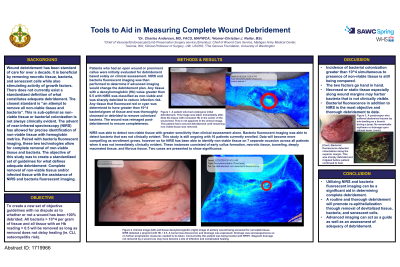Clinical Research
(CR-002) Tools to Aid in Measuring Complete Wound Debridement
Thursday, May 16, 2024
7:30 PM - 8:30 PM East Coast USA Time

Homer-Christian Reiter, BSc
Introduction: Wound debridement has been standard of care for over a decade. It is beneficial by removing necrotic tissue, bacteria, and senescent cells while also stimulating activity of growth factors. There does not currently exist a standardized definition of what constitutes adequate debridement. The closest standard is “an attempt to remove all non-viable tissue and bacteria”. This is sub-optimal as non-viable tissue or bacterial colonization is not always clinically evident. The advent of near-infrared spectroscopy (NIRS) has allowed for precise identification of non-viable tissue with hemoglobin metrics. Paired with bacteria fluorescent imaging, these two technologies allow for complete removal of non-viable tissue and bacteria. The objective of this study was to create a standardized set of guidelines for what defines adequate debridement: Complete removal of non-viable tissue and/or infected tissue with the assistance of NIRS and bacteria fluorescent imaging.
Methods: Patients who had an open wound or prominent callus were initially evaluated for debridement based solely on clinical assessment. NIRS and bacteria fluorescent imaging was then performed to determine if advanced imaging would change the debridement plan. Any tissue with a deoxyhemoglobin (Hb) value greater than 0.5 with NIRS was classified as non-viable and was sharply debrided to reduce infection risk. Any tissue that fluoresced red or cyan was determined to have greater than 10^4 bacteria/gram of tissue and was thoroughly cleansed or debrided to remove colonized bacteria. The wound was reimaged post-debridement to ensure completeness.
Results: NIRS was able to detect non-viable tissue with greater sensitivity than clinical assessment alone. Bacteria fluorescent imaging was able to detect bacteria that was not clinically evident.
Discussion: Utilizing NIRS and bacteria fluorescent imaging can be a significant aid in determining complete debridement. A routine and thorough debridement will promote re-epithelialization through removal of devitalized tissue, bacteria, and senescent cells. Advanced imaging can act as a guide as well as an assessment of adequacy of debridement.
Methods: Patients who had an open wound or prominent callus were initially evaluated for debridement based solely on clinical assessment. NIRS and bacteria fluorescent imaging was then performed to determine if advanced imaging would change the debridement plan. Any tissue with a deoxyhemoglobin (Hb) value greater than 0.5 with NIRS was classified as non-viable and was sharply debrided to reduce infection risk. Any tissue that fluoresced red or cyan was determined to have greater than 10^4 bacteria/gram of tissue and was thoroughly cleansed or debrided to remove colonized bacteria. The wound was reimaged post-debridement to ensure completeness.
Results: NIRS was able to detect non-viable tissue with greater sensitivity than clinical assessment alone. Bacteria fluorescent imaging was able to detect bacteria that was not clinically evident.
Discussion: Utilizing NIRS and bacteria fluorescent imaging can be a significant aid in determining complete debridement. A routine and thorough debridement will promote re-epithelialization through removal of devitalized tissue, bacteria, and senescent cells. Advanced imaging can act as a guide as well as an assessment of adequacy of debridement.

.jpeg)